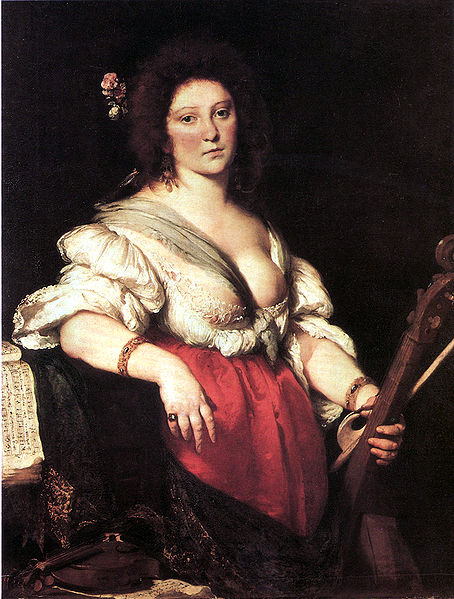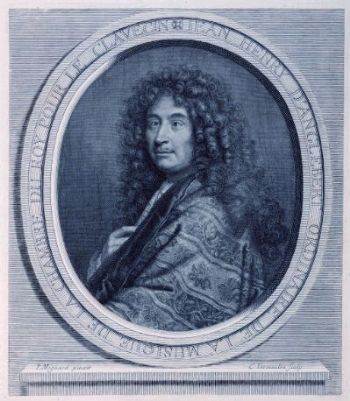<Back to Index>
- Singer and Composer Barbara Strozzi, 1619
- Composer, Harpsichordist and Organist Jean - Henri d'Anglebert, 1629
PAGE SPONSOR

Barbara Strozzi (also called Barbara Valle; baptized 6 August 1619 – 11 November 1677) was an Italian Baroque singer and composer.
Born in Venice, Barbara was adopted and baptized into the Strozzi family. She was most likely illegitimate, daughter of Giulio Strozzi and Isabella Garzon, his long time servant and heir. Giulio encouraged his daughter's talent, even creating an academy in which Barbara’s performances could be validated and displayed publicly. He seemed to be interested in exhibiting her considerable vocal talents to a wider audience. However, her singing was not her only talent. She was also compositionally gifted, and her father arranged for her to study with composer Francesco Cavalli.
It is conceivable that Strozzi may have been a courtesan, however, she also may have merely been the target of jealous slander by her male contemporaries. She appears to have led a quiet, if not slightly unusual life; there is evidence that at least three of her four children were fathered by the same man, Giovanni Paolo Vidman. He may have been her husband or a paramour. After Vidman's death it is likely that Strozzi supported herself by means of her savvy investments and by her compositions. He did not, apparently, leave anything to her or her children in his will.
Strozzi died in Padua in 1677 aged 58. Strozzi is believed to have been buried at Eremitani. When she died without leaving a will, her son Giulio Pietro claimed her inheritance.
Strozzi is unique among both male and female composers for publishing her works in single composer volumes, rather than in collections. She was said to be "the most prolific composer - man or woman - of printed secular vocal music in Venice in the Middle of the century." Her output is also unique in that it only contains secular vocal music, with the exception of one volume of sacred songs. She was renowned for her poetic ability as well as her compositional talent. Her lyrics were often poetic and well articulated.
Nearly three - quarters of her printed works were written for soprano, but she also published works for other voices. Her compositions are firmly rooted in the seconda pratica tradition. Strozzi’s music evokes the spirit of Cavalli, heir of Monteverdi. However, her style is more lyrical, and more dependent on sheer vocal sound.
Many of the texts for her early pieces were written by her father
Giulio. Later texts were written by her father's friends, and many
compositions she wrote her own texts for.

Jean-Henri d'Anglebert (baptized 1 April 1629 – 23 April 1691) was a French composer, harpsichordist and organist. He was one of the foremost keyboard composers of his day.
D'Anglebert's father Claude Henry dit Anglebert was an affluent shoemaker in Bar-le-Duc. Nothing is known about the composer's early years and musical education. Since he at one time composed a tombeau for Jacques Champion de Chambonnières, it is possible that Chambonnières was his teacher — or at any rate a friend for whom D'Anglebert had much respect. The earliest surviving manuscript with D'Anglebert's music dates from 1650 – 59. It also contains music by Louis Couperin and Chambonnières, and possibly originated in their immediate circle; thus already by the mid 1650s D'Anglebert must have been closely associated with the most prominent French harpsichordists of the time. The earliest reference to D'Anglebert survives in his marriage contract from 11 October 1659. D'Anglebert married Magdelaine Champagne, sister - in - law of organist François Roberday. In the contract, he is described as bourgeois de Paris, suggesting that by 1659 he was already well established in Paris. How he left Bar-le-Duc and settled in Paris remains unknown.
D'Anglebert's career in Paris must have begun at the Jacobins church
in Rue St. Honoré, where he was still organist in January 1660. In
August 1660 he succeeded Henri Dumont as harpsichordist to Philippe I, Duke of Orléans,
the King's younger brother. He kept the position until at least 1668,
but in the meantime, in 1662, he bought the reversion of the post of
harpsichordist from Chambonnières, who had been recently disgraced at
the court; Chambonnières kept the salary, but D'Anglebert assumed the
duties. He served as royal harpsichordist until his son
Jean - Baptiste - Henry became his reversioner in 1674. After 1679
D'Anglebert served Dauphine Duchess Maria Anna Victoria of Bavaria, who died in 1690. D'Anglebert died the following year, on 23 April. His only published work, Pièces de clavecin, appeared just two years before, in 1689. The rest of his music — mostly harpsichord works, but also five fugues and a quatuor for organ — survives in manuscripts.
D'Anglebert's principal work is a collection of four harpsichord suites published in 1689 in Paris under the title Pièces de clavecin. The volume is dedicated to Marie Anne de Bourbon, a talented amateur harpsichordist who later studied under François Couperin. Apart from its contents, which represent some of the finest achievements of the French harpsichord school (and show, among other things, D'Anglebert's thorough mastery of counterpoint and his substantial contribution to the genre of unmeasured prelude), Pièces de clavecin is historically important on several other counts. The collection was beautifully engraved with utmost care, which set a new standard for music engraving. Furthermore, D'Anglebert's table of ornaments is the most sophisticated before François Couperin's (which only appeared a quarter of a century later, in 1713). It formed the basis of J. S. Bach's own table of ornaments (Bach copied D'Anglebert's table in c. 1710), and provided a model for other composers, including Rameau. Finally, D'Anglebert's original pieces are presented together with his arrangements of Lully's orchestral works. D'Anglebert's arrangements are, once again, some of the finest pieces in that genre, and show him experimenting with texture to achieve an orchestral sonority.
Most of D'Anglebert's other pieces survive in two manuscripts, one of which contains, apart from the usual dances, harpsichord arrangements of lute pieces by composers such as Ennemond Gaultier, Denis Gaultier, and René Mesangeau. They are unique pieces, for no such arrangements by other major French harpsichord composers are known. The second manuscript contains even more experimental pieces by D'Anglebert, in which he tried to invent a tablature - like notation for keyboard music to simplify the notation of style brisé textures.
D'Anglebert's only surviving organ works are five fugues and a quatuor (old French term for a four voice contrapuntal organ piece). The fugues all elaborate on variations of the same subject, thus forming an extended ricercare (or a miniature The Art of the Fugue). The quatuor, one of the few surviving pieces of its kind, is built around three themes derived from the Kyrie Cunctipotens; it is to be played on three keyboards and the pedal keyboard.